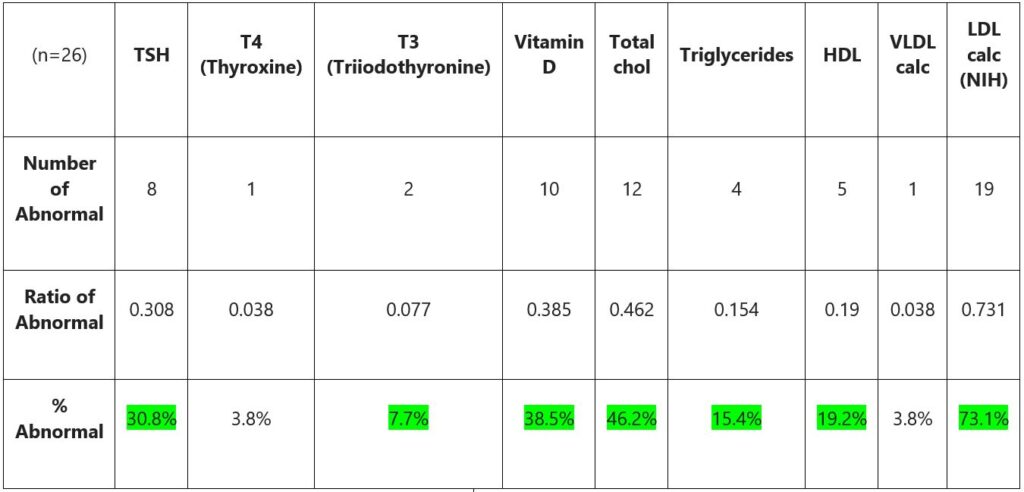Episode 2: When to get a blood test for PFAS (ADHD, pain, high cholesterol, low vitamin D, thyroid dysfunction, neurological complaints, infertility, cancer)
Daniel Williams, MD
Introduction
The globe has become polluted to such an extent that industrial contaminants can be found in the air, soil, water, food supply and is a cyclical problem in the trash and disposal industry.1-3 The processing and packaging of food itself and the agricultural contamination add these chemicals into the human dietary consumption chain.4, 5 Many contaminants can be inhaled or absorbed through the skin during bathing, showering, brushing the teeth, etc.
Polyfluoroalkyl Substances (PFAS) represent 15,000 different variations of chemical compounds. The known health effects from PFAS exposure can be summarized as neurotoxic, carcinogenic, and fertility threat.6-8 Clinically, patients exhibit known laboratory results, signs and symptoms when exposed to PFAS including high cholesterol, low Vitamin D, thyroid disorders, Attention-Deficit Hyperactivity Disorder9-11. There are no studies on increasing its bioelimination, yet the media has dubbed these “forever chemicals” because the original PFOS (with 8 carbons) takes over 27 years to eliminate from the body. These chemicals are still being released into the water supply in thousands of communities according to the United States Environmental Working Group.
Unfortunately, this Environmental Working Group Map is incomplete. It fails to list every environmental contamination site leaving citizens to have to test their own water and blood. One example of a PFAS contamination site is in Springfield, Missouri where there is PFAS in the water supply due to ongoing industrial contamination.12 The PFAS is spilling into the James River that flows Southwest from Springfield to Table Rock Lake in Branson, Missouri, which is a popular tourist destination. This water contamination is thought to be far-reaching, affecting Northwest Arkansas and is gaining the attention of tort attorneys. The PFAS level in Springfield, MO is above the limit placed by the Environmental Protection Agency at 4 parts per trillion and the Missouri Department of Natural Resources has organized a PFAS Workgroup to help the community address the contamination.
In this environment, the same clinical trend in the scientific literature was visibly noticed by the staff at a busy psychiatric urgent care. Otherwise healthy people had low Vitamin D, thyroid dysfunction, abnormal lipids, pain and symptoms of Attention Deficit Hyperactivity Disorder at all ages. In the majority of cases, these were the only medical problems these people had. The rates of abnormal labs and medications/supplements for Vitamin D, thyroid dysfunction and dyslipidemia in this vulnerable population are reported here.
Methods
Chart reviews were conducted for patients attending a psychiatric urgent care in Springfield, MO in July 2024. Inclusion criteria was having had a full panel of laboratory studies within the previous 18 months. Labs had to include a Vitamin D level, full lipid panel and full thyroid panel with at least TSH, T4 (conjucated/unconjucated), and T3 . Exclusion criteria were patients missing laboratory studies for either Vitamin D, lipid panel or thyroid panel. Age, gender, number of medical diagnoses, vitamin D supplement usage, TSH, T4 (or free T4), T3, total cholesterol, triglycerides, HDL, calculated VLDL, calculated HDL, and statin use were studied.
Results
Twenty-six patients were included in this study (n=26). Ages ranged from 8-68. Thirty-eight percent were male and 62% were female which is typical in outpatient psychiatric practice. Out of nine total lab tests, seven labs were above the expected 5% outliers of the reference range (Table 1). Over 73% of patients had elevated calculated LDL, 46.2% had abnormal total cholesterol, 38.5% had low Vitamin D, 30.8% had abnormal TSH values, 19.2% had low HDL, 15.4% had elevated triglycerides, and 7.7% had abnormal T3 triiodothyronine values. Thyroxine (T4) and calculated VLDL were the only tests that had less than the 5% of patients with abnormal results.

Discussion
Bioaccumulation of pollutants is known to cause endocrine disruption. Early detection of bioaccumulation is important for medical surveillance efforts to understand the scope of the problem, further identify at-risk populations, and contribute to reducing the current cancer epidemic.
This study demonstrated the need for further research in epidemiologic studies, hazard identification, mitigation of pollutants, education for the public and researching detoxification outcomes.
Limitations of this study include low sample size, lack of controls for medical problems and medications (except for Vitamin D supplementation which was studied).
Recommendations
The following is recommended as a Decision Tool to help guide an individual to get a PFAS blood test. The presence of the Primary Criteria is a strong recommendation for getting a blood test for PFAS. The Secondary Criteria may also be considered to increase the recommendation likelihood for a PFAS blood test.
Primary Criteria
High Cholesterol
Low Vitamin D
Thyroid disorder
ADHD or Pain
Secondary Criteria
Neurological complaint (impulsivity, autism, etc)
Endocrine disorder
Infertility
Cancer
References
1. Pizzorno J. Fluorocarbons (PFAS)-The Forever Chemicals. Integr Med (Encinitas). Dec 2023;22(6):6-10.
2. National Academies of Sciences E, Medicine, Health, et al. The National Academies Collection: Reports funded by National Institutes of Health. Guidance on PFAS Exposure, Testing, and Clinical Follow-Up. National Academies Press (US)
Copyright 2022 by the National Academy of Sciences. All rights reserved.; 2022.
3. Stoiber T, Evans S, Naidenko OV. Disposal of products and materials containing per- and polyfluoroalkyl substances (PFAS): A cyclical problem. Chemosphere. Dec 2020;260:127659. doi:10.1016/j.chemosphere.2020.127659
4. Snedeker SM. Toxicants in Food Packaging and Household Plastics: Exposure and Health Risks to Consumers. Molecular and Integrative Toxicology. Springer; 2014.
5. Tittlemier SA, Pepper K, Seymour C, et al. Dietary Exposure of Canadians to Perfluorinated Carboxylates and Perfluorooctane Sulfonate via Consumption of Meat, Fish, Fast Foods, and Food Items Prepared in Their Packaging. Journal of Agricultural and Food Chemistry. 2007/04/01 2007;55(8):3203-3210. doi:10.1021/jf0634045
6. Joglekar R, Liddie J, Olson ED, Faber S, Schnettler J. The Environmental Justice Implications of PFAS. Env’t L Rep. 2024;54:10911.
7. Rosato I, Bonato T, Fletcher T, Batzella E, Canova C. Estimation of per- and polyfluoroalkyl substances (PFAS) half-lives in human studies: a systematic review and meta-analysis. Environmental Research. 2024/02/01/ 2024;242:117743. doi:https://doi.org/10.1016/j.envres.2023.117743
8. Brown-Leung JM, Cannon JR. Neurotransmission Targets of Per- and Polyfluoroalkyl Substance Neurotoxicity: Mechanisms and Potential Implications for Adverse Neurological Outcomes. Chemical Research in Toxicology. 2022/08/15 2022;35(8):1312-1333. doi:10.1021/acs.chemrestox.2c00072
9. Nelson JW, Hatch EE, Webster TF. Exposure to polyfluoroalkyl chemicals and cholesterol, body weight, and insulin resistance in the general U.S. population. Environ Health Perspect. Feb 2010;118(2):197-202. doi:10.1289/ehp.0901165
10. Zhao H, Ren Y, Ni J, et al. Sex-specific association of per- and polyfluoroalkyl substances (PFAS) exposure with vitamin D concentrations in older adults in the USA: an observational study. Environmental Health. 2024/11/18 2024;23(1):100. doi:10.1186/s12940-024-01140-9
11. Coperchini F, Croce L, Ricci G, et al. Thyroid Disrupting Effects of Old and New Generation PFAS. Front Endocrinol (Lausanne). 2020;11:612320. doi:10.3389/fendo.2020.612320
12. Mieze M. City Utilities sues 3M for knowingly contaminating James River with ‘forever chemicals’. Springfield News-Leader. June 5, 2024. https://www.news-leader.com/story/news/local/ozarks/2024/06/05/3m-sued-by-city-utilities-for-knowingly-contaminating-water/73979279007/

